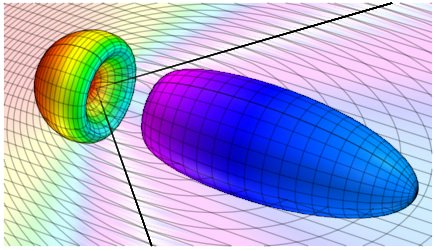In a matter dominated world made up of different particles for which search is still going on to find the God’s particle or so, according to Einstein’s theory of relativistic concept of mass variation Special theory of relativity states that nothing that is moving initially slower than the speed of light can be accelerated to exceed the speed of light. This is not strictly speaking the same as the statement that nothing can travel faster than light. In special relativity, it is impossible to accelerate an object to the speed of light, or for a massive object to move at the speed of light. However, it might be possible for an object to exist which always moves faster than light. Photon (light particle or quanta of light) moves with velocity of light because its rest mass is zero or it is already moving with the speed of light. Another fundamental fact of relativity is that E² − p² =mo² (working in units where c=1) where E is an object's energy, p is its momentum, and m0 is its rest mass, which we'll just call 'mass'. Rest mass will have two values and are given the names tardyon (or bradyon in more modern usage) and luxon, for "slow particle" and "light particle".
Tachyon is the name given to the supposed "fast particle" which would move with v>c. We can now deduce many interesting properties of tachyons, for example, they accelerate (p goes up) if they lose energy (E goes down). Furthermore, a zero-energy tachyon is "transcendent", or moves infinitely fast. This has profound consequences; for example, let's say that there were electrically charged tachyons. Since they would move faster than the speed of light in the vacuum, they should produce Cherenkov radiation. This would lower their energy, causing them to accelerate more. In other words, charged tachyons would probably lead to a runaway reaction releasing an arbitrarily large amount of energy. This suggests that coming up with a sensible theory of anything except free (non-interacting) tachyons are likely to be difficult. Heuristically, the problem is that we can get spontaneous creation of tachyon-anti-tachyon pairs, and then do a runaway reaction, making the vacuum unstable. To treat this precisely requires quantum field theory, which gets complicated.
The name 'tachyon' (from the Greek 'tachys,' meaning swift/speedy)- particle that travel faster than the speed of light- was first proposed by physicist Arnold Sommerfeld, and was coined by the late Gerald Feinberg of Columbia University. A renowned Indian origin scientist Prof E.C.G. Sudarshan (while working at the University of Texas, USA) (source: http://www.tifr.res.in/) proposed the existence of tachyons. Gerald Feinberg proposed that tachyonic particles could be quanta of a quantum field with imaginary mass. However, it was soon realized that excitations of such imaginary mass fields do not under any circumstances propagate faster than light, and instead the imaginary mass gives rise to an instability known as tachyon condensation. Nevertheless, in modern physics the term "tachyon" often refers to imaginary mass fields rather than to faster-than-light particles. Such fields have come to play a significant role in modern physics.
Characteristics of tachyons
- Briefly, tachyons are theoretically postulated particles that travel faster than light and have 'imaginary' masses.
- Tachyons have never been found in experiments as real particles traveling through the vacuum, but scientists predict theoretically that tachyon-like objects exist as faster-than-light 'quasiparticles' moving through laser-like media. Laser-like media is a technical term referring to those media that have inverted atomic populations, the conditions prevailing inside a laser.
- For present purposes, the interesting fact is a curious property: for some observers tachyons travel backwards in time.
- A hypothetical particle that travels faster than light, a tachyon has the possibility of escaping the interior of the black hole, though it is not necessarily the case that it will do so.
- They exist as particle-like excitations, similar to other quasiparticles called phonons and polaritons that are found in solids.
- Experiments at Berkeley are being planned to detect tachyon-like quasiparticles. There are strong scientific reasons to believe that such quasiparticles really exist, because Maxwell's equations, when coupled to inverted atomic media, lead inexorably to tachyon-like solutions.
- Quantum optical effects can produce a different kind of 'faster than light' effect. There are actually two different kinds of 'faster-than-light' effects i) that photons which tunnel through a quantum barrier can apparently travel faster than light, ii) an effect related to the famous Einstein-Podolsky-Rosen phenomenon, in which two distantly separated photons can apparently influence one anothers' behaviors at two distantly separated detectors. It has been found experimentally that twin photons emitted from a common source (a down-conversion crystal) behave in a correlated fashion when they arrive at two distant interferometers. This phenomenon can be described as a 'faster-than-light influence' of one photon upon its twin.
- No experimental evidence for the existence of such particles has been found.
- Tachyons can be assigned properties of normal matter such as spin, as well as an antiparticle (the antitachyon).
- And amazingly, modern presentations of tachyon theory actually allow tachyons to actually have real mass.
- It has been proposed that tachyons could be produced from high-energy particle collisions, and tachyon searches have been undertaken in cosmic rays.
- If such particles did exist, they could be used to build a tachyonic antitelephone and send signals faster than light.
